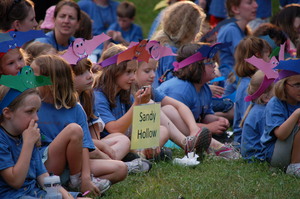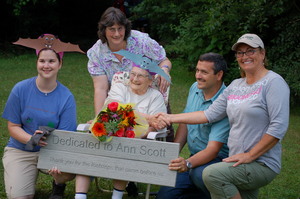Girl Scouts help bats, bats help Girl Scouts

Photo Courtesy Girl Scouts Heart of Michigan
Now, Girl Scouts in the Heart of Michigan council are helping bats, by launching The Bat Project, to build safe, healthy breeding havens at every camp. Currently, the bat population in the United States is threatened with White Nose Syndrome (WNS), which scientists suspect is a fungal illness. Michigan is free of WNS so far.
Girl Scouts Heart of Michigan will celebrate the official “grand opening” of the council’s first bat haven, the Ann Scott Bat House, on Saturday, October 23, at Camp Crawford, 8483 Crane Road in Milan. The festivities will begin at 4 p.m., with a short program at 4:30 p.m. Families are welcome to attend the grand opening, view the house where bats will breed and learn about these valuable mammals.
“Building large bat houses is one of the very best things that people can do to protect the species of bats that normally hibernate in caves, “ said Marne Titchenell, wildlife program specialist for the Ohio State University Extension Service. The bat haven planned at Camp Crawford in Milan will house up to 7,000 bats.
“Cave-hibernating bats, such as the little brown bat and big brown bat, are dying at alarming rates throughout New England and the Northeast, “ said Titchenell. “Before WNS reaches Michigan, large bat homes will allow breeding colonies to establish themselves and build up the population of little brown bats and big brown bats. “

Bat House Donor Ann Scott and Jan Barker, Girl Scout CEO
Photo Courtesy Girl Scouts Heart of Michgan
The U.S. Fish and Wildlife Service has described WNS as “the worst wildlife crisis in memory.” Environmental groups warn that loss of bats will lead to increasing mosquito populations and increased costs to farmers (and, ultimately, consumers) for agricultural pest control.
Titchenell said that bat populations in Vermont have decreased from 700,000 in 2006 to 100,000 this year. She explained that the small mammals mate in the fall, hibernate, then conceive and produce their “pups” in the spring. Female bats have only one to three pups each year. WNS attacks bats while they are hibernating. As the fungal disease spreads, the population could be wiped out.
The first bat house is named for Ann Scott, a longtime Girl Scout volunteer whose donation is making the first bat house a reality. Ann celebrated her 90th birthday a little early this summer and asked friends and family to support The Bat Project in lieu of birthday gifts. So far, $7,380 has been donated.
“Bats will bring comfort, conservation and community to all of our GSHOM camps, starting with the expected 7,000 bats that will make the new bat house at Camp Crawford their home,” said Jason Maddock, GSHOM outdoor education specialist. “Girls will be more comfortable at camp as the mosquito population declines. Bats can eat up to 1,000 mosquito-sized insects per hour!”
“Bats are remarkable mammals,” said Maddock. “They certainly don’t deserve their scary reputation. Especially now at Halloween time, we should learn to appreciate the value of bats in the balance of nature.”
As part of The Bat Project, GSHOM will build bat havens at each of its outdoor facilities and will develop curriculum packets to teach girls about bats. Maureen Schell, of ECO Discovery and Bat Conservation International, will run the bat program at Camp Crawford. "Learning more about bats and their place in the environment can open a world of leadership benefits for girls," said Schell. "As girls learn about the myths and realities of this gentle mammal, they will use life skills like critical thinking to react to the challenge of helping to protect the bats that share our habitat."
Char Luttrell is a Communications Specialist for Girl Scouts Heart of Michigan. She is learning to love bats. You can reach her at cluttrell@gshom.org.


Comments
Beth Braaksma
Fri, Oct 8, 2010 : 10:34 a.m.
If the Girl Scout website is down, you can always call the office to make a donation. The number is 1-800-49-SCOUT. Ask to speak with the fund development team. You can also go to their home page: www.gshom.org and click on "donate." Then, click on "donate now." Under the program designation section there is a way to select "The Bat Project."
A2K
Thu, Oct 7, 2010 : 2:53 p.m.
This is really cool, bravo! I've heard that bats prefer bat houses that are dark-colored...my husband and I often see them flying around in the evening in our backyard, and have thought about installing a house for them to roost in.
justaposter
Thu, Oct 7, 2010 : 10:40 a.m.
The Bat Project link isn't working. Is there a donate option?
Ann E. Edwards
Thu, Oct 7, 2010 : 10:23 a.m.
This is great! Bats are wonderful creatures.